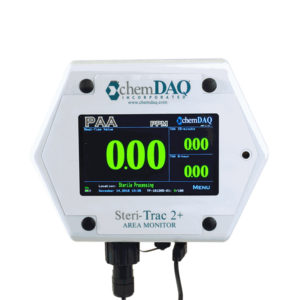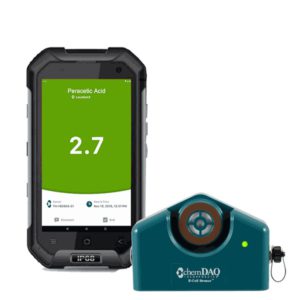Peracetic Acid
Peracetic Acid Gas Detectors – Gas detectors from a1-cbiss for the detection of Peracetic Acid
CAS Number: 79-21-0
Proposed Limits;
TWA: 0.15ppm
STEL: 0.4ppm:
Properties
Peracetic Acid, also known as peroxyacetic acid or PAA, is an organic chemical compound that is used in a mixture with acetic acid and hydrogen peroxide in water.
It is a colourless liquid that has a strong vinegar-like odour that can be smelt at very low levels. It is a very powerful oxidant, which means that PAA removes electrons from other reactants. PAA chemical is highly reactive but breaks down to acetic acid (vinegar) and water so it leaves no harmful residue, which makes it the chemical of choice when looking for a food-safe antimicrobial.
The process for using peracetic acid as a disinfectant can simply be defined by a combination of hydrogen peroxide, acetic acid and water. PAA functions as a disinfectant by oxidizing the outer cell membrane of microbes. The stronger the solution of Peracetic acid, the more effective it is as an antimicrobial, but the more dangerous to everyone around. This highly biocidal oxidiser removes surface contaminants, such as viruses and spores, in many different ways.
Where is it found
- Treatment of bottles and beverage containers prior to filling
- Poultry, meat, seafood, fruits, vegetables and other food items to prevent foodborne illnesses
- Disinfection of medical devices in hospitals and manufacturing
- Wastewater treatment facilities during water purification process prior to discharge
- Agriculture storage – For making an area sterile between seasonal crops
- Fracking, gas and oil operations as antimicrobial
- Eliminate powdery mildew on plants
What are the dangers of Peracetic Acid?
According to NIOSH. Concentrations of 15% or higher, also give rise to fire and explosion hazards and reactivity issues. It is important to ensure that training and safety precautions for peracetic acid are in place.
Another major concern is that peracetic acid has a pungent vinegar type odour, even at low levels. If you are working around PAA and do not smell it, it’s more than likely it is due to olfactory fatigue. Olfactory fatigue is also known as nose blindness or odour fatigue. While making sure the items you’re disinfecting are safe, make sure to keep track of peracetic acid safety where you work.
- Eye irritation: eye damage after prolonged exposure
- Respiratory distress: fluid in the lungs after high level of exposure (edema)
- Nose and throat irritation
- Asthma associated with workplace exposures
- Skin irritation dermatitis
- Data on animals showed: hemorrhage, edema, and pulmonary consolidation
Regulations/ Guidelines for Peracetic Acid
Exposure limits and guidelines when using peracetic acid disinfection have been set by a number of national agencies including the following. Make sure to follow these for proper PAA safety and training of staff:
Best Safety Practices for Peracetic Acid
Monitoring PAA
It is highly recommended to use a combination of continuous fixed area monitoring and portable area monitoring to find danger zones throughout any facility that uses Peracetic Acid.
Continuous fixed area monitoring is recommended in the following areas:
- Near concentrated PAA storage tanks, dilution lines, and pump stations
- Any area where employees have experienced symptoms or known risks are present for exposure – endoscopic units
Portable monitoring is recommended as a daily routine through danger zones combined with any additional spot checks needed throughout the day.






